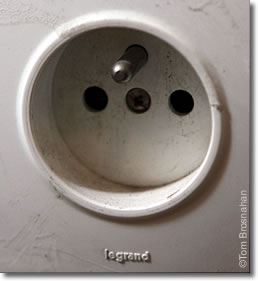Also sticking the probes into a MR16 holder is not easy.
What on earth do you mean? There is NO SUCH THING as an MR16 holder. MR 16 means multifaceted reflector 16/8" diameter.
Also sticking the probes into a MR16 holder is not easy.

It really does not matter if the MR16 lamp is SES, E14, E27, E28, ES, GU10, G5.3 or even BA22d trying to stick probes into the lamp to measure the supply is not easy, in fact often impossible as with many switch mode power supplies they will close down without a load so there is nothing to measure. Industrial premises often have internal rules as to what voltages are used with which lamp holders, often E27 was used for 110 volt supplies and BA22d for 230 volt supplies, with the exception of discharge lighting where you can't get the bulb in BA22d base anyway. In the main we use G5.3 for extra low voltage howeverWhat on earth do you mean? There is NO SUCH THING as an MR16 holder. MR 16 means multifaceted reflector 16/8" diameter.

Interesting both kHz and 50Hz at same time, the point is the same however if not 50Hz then a capacitor used as a current limiting device will allow a different amount of current through than the designers intended, also if you look at a basic radioI don't have the actual scope screen shot but this is very similar to the wave form found on the output of a SMPS 12 volt AC supply
View attachment 116485

It appeared to be a something akin to a 50 Hz sine wave amplified by a class D amplifier to produce 20 (?) watts of power at 12 volts 50 Hz.Interesting both kHz and 50Hz
It's an AM transmitter.
It's sending out a 50Hz signal on the 300000m band.

AM = amplitude modulated since the transmission is not modulated it is hardly a AM transmitter although it could be a transmitter, the second pdf I linked to states 40 kHz as output frequency, Low Frequency is used for things like time signals, and aircraft navigation beacons, so to cause interference on this frequency is serious.It's an AM transmitter.
It's sending out a 50Hz signal on the 300000m band.
That is possible with most of the SMPS devices manufactured and marketed by reputable companies which have instructions and information supplied with them. Less reputable companies do not include adequate instructions / information and too many companies give no information. A few even lie and say their SMPS device is a direct replacement for inductive transformers.The problem with electronic transformers is they are only able to comply with electromagnet compatibility requirements if the manufacturers instructions are complied with,


If you need to find a tradesperson to get your job done, please try our local search below, or if you are doing it yourself you can find suppliers local to you.
Select the supplier or trade you require, enter your location to begin your search.
Are you a trade or supplier? You can create your listing free at DIYnot Local
